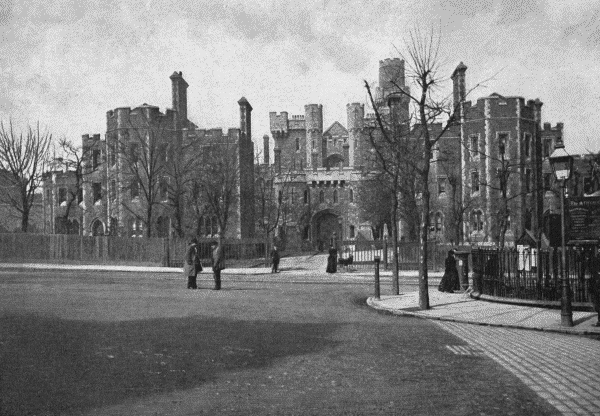|
Alice Wheeldon
Alice Ann Wheeldon (27 January 1866 – 21 February 1919) was a British supporter of universal and women's suffrage and anti-war campaigner. She was convicted in 1917, along with her daughter, Winnie, and son-in-law, Alfred Mason, of conspiracy to murder the Prime Minister, David Lloyd George. Some of the evidence given in the case against them appears to have been fabricated on behalf of "a government eager to disgrace the anti-war movement". Early life Alice Ann Marshall was born in Derby, England, the daughter of an engine driver who had worked as a house servant when young. In 1886 she married William Augustus Wheeldon, who was a widowed train driver and later a commercial traveller. They had three daughters, Nellie (born 1888), Harriette Ann (Hettie) (born 1891) and Winnie (born 1893), and a son, William Marshall (Willie, born 1892). Willie's application for exemption from military service as a conscientious objector was rejected in 1916. Political activism Wheeldon wa ... [...More Info...] [...Related Items...] OR: [Wikipedia] [Google] [Baidu] |
Derby
Derby ( ) is a city and unitary authority area in Derbyshire, England. It lies on the banks of the River Derwent in the south of Derbyshire, which is in the East Midlands Region. It was traditionally the county town of Derbyshire. Derby gained city status in 1977, the population size has increased by 5.1%, from around 248,800 in 2011 to 261,400 in 2021. Derby was settled by Romans, who established the town of Derventio, later captured by the Anglo-Saxons, and later still by the Vikings, who made their town of one of the Five Boroughs of the Danelaw. Initially a market town, Derby grew rapidly in the industrial era. Home to Lombe's Mill, an early British factory, Derby has a claim to be one of the birthplaces of the Industrial Revolution. It contains the southern part of the Derwent Valley Mills World Heritage Site. With the arrival of the railways in the 19th century, Derby became a centre of the British rail industry. Derby is a centre for advanced transport manufactu ... [...More Info...] [...Related Items...] OR: [Wikipedia] [Google] [Baidu] |
Holloway (HM Prison)
HM Prison Holloway was a closed category prison for adult women and young offenders in Holloway, London, England, operated by His Majesty's Prison Service. It was the largest women's prison in western Europe, until its closure in 2016. History Holloway prison was opened in 1852 as a mixed-sex prison, but due to growing demand for space for female prisoners, particularly due to the closure of Newgate, it became female-only in 1903. Before the first world war, Holloway was used to imprison those suffragettes who broke the law. These included Emmeline Pankhurst, Emily Davison, Constance Markievicz (also imprisoned for her part in the Irish Rebellion), Charlotte Despard, Mary Richardson, Dora Montefiore, Hanna Sheehy-Skeffington, and Ethel Smyth. In 1959, Joanna Kelley became Governor of Holloway. Kelley ensured that long-term prisoners received the best accommodation and they were allowed to have their own crockery, pictures and curtains. The prison created "family" groups ... [...More Info...] [...Related Items...] OR: [Wikipedia] [Google] [Baidu] |
Hunger Strike
A hunger strike is a method of non-violent resistance in which participants fast as an act of political protest, or to provoke a feeling of guilt in others, usually with the objective to achieve a specific goal, such as a policy change. Most hunger strikers will take liquids but not solid food. In cases where an entity (usually the state) has or is able to obtain custody of the hunger striker (such as a prisoner), the hunger strike is often terminated by the custodial entity through the use of force-feeding. Early history Fasting was used as a method of protesting injustice in pre-Christian Ireland, where it was known as ''Troscadh'' or ''Cealachan''. Detailed in the contemporary civic codes, it had specific rules by which it could be used. The fast was often carried out on the doorstep of the home of the offender. Scholars speculate that this was due to the high importance the culture placed on hospitality. Allowing a person to die at one's doorstep, for a wrong of which ... [...More Info...] [...Related Items...] OR: [Wikipedia] [Google] [Baidu] |
Aylesbury Prison
His Majesty's Young Offender Institution (HMYOI) Aylesbury is a Young Offender Institution situated in Aylesbury, Buckinghamshire, England. It is located on the north side of the town centre, on Bierton Road and is operated by His Majesty's Prison Service. History There has been a prison or gaol of some description in Aylesbury since 1810. The current prison has been on its present site since 1847. It is of early Victorian design and was modelled on Reading County Gaol, The site was in an area of public buildings that also included the workhouse (formerly the Tindal Centre) and the Manor House Hospital. Since construction, the prison has gone through a variety of changes, starting as a county gaol, then became an adult women's prison in 1890, changing to a girls' borstal in the 1930s, and between 1959-1961 was an adult male prison, after which it became a male ''YOI'', and since 1989 has held only male long-term prisoners. [...More Info...] [...Related Items...] OR: [Wikipedia] [Google] [Baidu] |
Old Bailey
The Central Criminal Court of England and Wales, commonly referred to as the Old Bailey after the street on which it stands, is a criminal court building in central London, one of several that house the Crown Court of England and Wales. The street outside follows the route of the ancient wall around the City of London, which was part of the fortification's '' bailey'', hence the metonymic name. The Old Bailey has been housed in a succession of court buildings on the street since the sixteenth century, when it was attached to the medieval Newgate gaol. The current main building block was completed in 1902, designed by Edward William Mountford; its architecture is recognised and protected as a Grade II* listed building. An extension South Block was constructed in 1972, over the former site of Newgate gaol which was demolished in 1904. The Crown Court sitting in the Old Bailey hears major criminal cases from within Greater London. In exceptional cases, trials may be referr ... [...More Info...] [...Related Items...] OR: [Wikipedia] [Google] [Baidu] |
Derby Guildhall
Derby Guildhall is a municipal building in the Market Place, Derby, England. It is a Grade II listed building. History A moot hall was first established in the Market Place area in 1204. This was replaced by a timber and plaster guildhall in 1500 which, in turn, made way for a stone guildhall which was designed by Richard Jackson in the Classical style and completed in 1730. A turret clock designed by John Whitehurst was installed on the face of the building in the mid-18th century. The next structure, which was designed by Matthew Habershon also in the Classical style, was built slightly to the south of the previous structures and was completed in 1828. It featured a large portico incorporating a large archway allowing access to the market hall on the ground floor, four Ionic columns on the first floor of the portico and a pediment above that. After the building was badly damaged by a fire, the interior and part of the structure was rebuilt to a design by Henry Duesbury ... [...More Info...] [...Related Items...] OR: [Wikipedia] [Google] [Baidu] |
Attorney-General
In most common law jurisdictions, the attorney general or attorney-general (sometimes abbreviated AG or Atty.-Gen) is the main legal advisor to the government. The plural is attorneys general. In some jurisdictions, attorneys general also have executive responsibility for law enforcement, prosecutions or even responsibility for legal affairs generally. In practice, the extent to which the attorney general personally provides legal advice to the government varies between jurisdictions, and even between individual office-holders within the same jurisdiction, often depending on the level and nature of the office-holder's prior legal experience. Where the attorney general has ministerial responsibility for legal affairs in general (as is the case, for example, with the United States Attorney General or the Attorney-General for Australia, and the respective attorneys general of the states in each country), the ministerial portfolio is largely equivalent to that of a Minister of Justice ... [...More Info...] [...Related Items...] OR: [Wikipedia] [Google] [Baidu] |
Arthur Henderson
Arthur Henderson (13 September 1863 – 20 October 1935) was a British iron moulder and Labour politician. He was the first Labour cabinet minister, won the Nobel Peace Prize in 1934 and, uniquely, served three separate terms as Leader of the Labour Party in three different decades. He was popular among his colleagues, who called him "Uncle Arthur" in acknowledgement of his integrity, his devotion to the cause and his imperturbability. He was a transitional figure whose policies were, at first, close to those of the Liberal Party. The trades unions rejected his emphasis on arbitration and conciliation, and thwarted his goal of unifying the Labour Party and the trade unions. Early life Arthur Henderson was born at 10 Paterson Street, Anderston, Glasgow, Scotland, in 1863, the son of Agnes, a domestic servant, and David Henderson, a textile worker who died when Arthur was ten years old. After his father's death, the Hendersons moved to Newcastle upon Tyne in the North-Eas ... [...More Info...] [...Related Items...] OR: [Wikipedia] [Google] [Baidu] |
Labour Party (UK)
The Labour Party is a List of political parties in the United Kingdom, political party in the United Kingdom that has been described as an alliance of Social democracy, social democrats, Democratic socialism, democratic socialists and trade unionists. The Labour Party sits on the Centre-left politics, centre-left of the political spectrum. In all general elections since 1922 United Kingdom general election, 1922, Labour has been either the governing party or the Her Majesty's Most Loyal Opposition (United Kingdom), Official Opposition. There have been six Labour List of prime ministers of the United Kingdom, prime ministers and thirteen Labour Cabinet of the United Kingdom, ministries. The party holds the annual Labour Party Conference, at which party policy is formulated. The party was founded in 1900, having grown out of the Labour movement, trade union movement and History of the socialist movement in the United Kingdom, socialist List of political parties in the United Kin ... [...More Info...] [...Related Items...] OR: [Wikipedia] [Google] [Baidu] |
Liberal Party (UK)
The Liberal Party was one of the two Major party, major List of political parties in the United Kingdom, political parties in the United Kingdom, along with the Conservative Party (UK), Conservative Party, in the 19th and early 20th centuries. Beginning as an alliance of Whigs (British political party), Whigs, free trade–supporting Peelites and reformist Radicals (UK), Radicals in the 1850s, by the end of the 19th century it had formed four governments under William Ewart Gladstone, William Gladstone. Despite being divided over the issue of Irish Home Rule Movement, Irish Home Rule, the party returned to government in 1905 and won a landslide victory in the 1906 United Kingdom general election, 1906 general election. Under Prime Minister of the United Kingdom, prime ministers Henry Campbell-Bannerman (1905–1908) and H. H. Asquith (1908–1916), the Liberal Party passed Liberal welfare reforms, reforms that created a basic welfare state. Although Asquith was the Leader of t ... [...More Info...] [...Related Items...] OR: [Wikipedia] [Google] [Baidu] |



_(cropped).jpg)

.png)